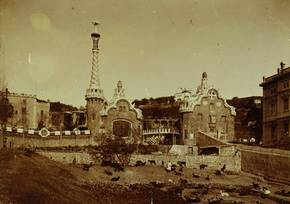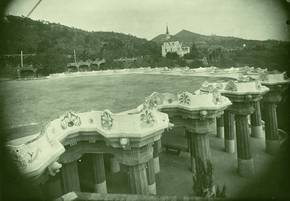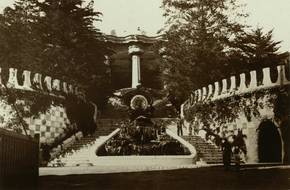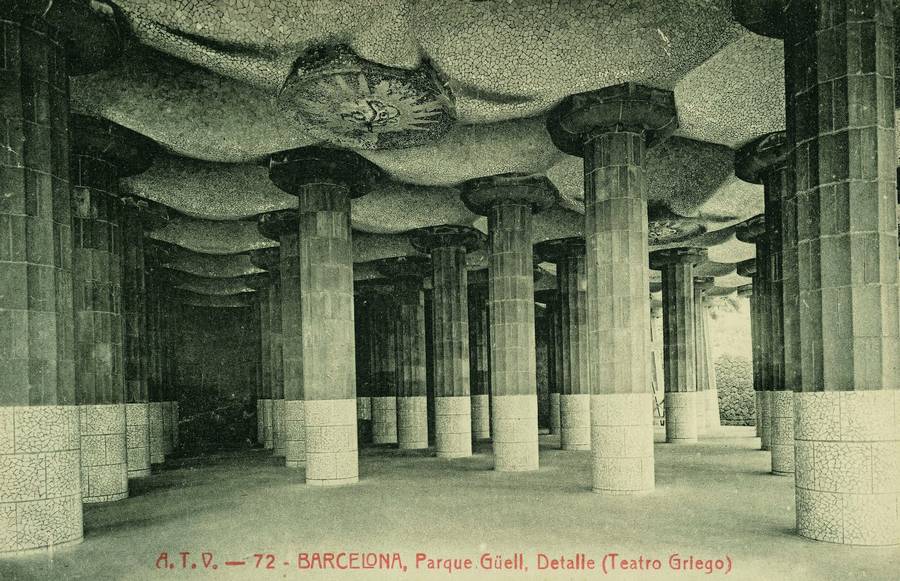The state of the Park Güell development
Eusebi Güell gave Gaudí the assignment of drawing up plans for developing an estate for well-off families on a large property he had acquired in the zone known popularly as the Muntanya Pelada (bare mountain). Its location was unbeatable, in a healthy setting and with splendid views over the sea and the Plain of Barcelona. Allowance was made for some 60 triangular-shaped plots on the estate, with a complex network of paths, viaducts and steps to cope with the lie of the land. The building conditions were highly restrictive, as only one-sixth of the plot could be built upon and the height and placement of the houses was ordained so that they could not block the view of the sea nor deprive neighbours of sunlight.

Park Güell, 1900-1910,
© unknown author. Arxiu Fotogràfic de Barcelona
Güell wanted to recreate the British residential parks, which is why he named it Park Güell, in English.
Gaudí respected the vegetation that was already growing on the property, such as the carob and olive trees, and when new species were introduced, he opted for Mediterranean plants that did not require much water. He also designed various systems for collecting and storing water, based on the irrigation systems he had learned about in the rural setting of his childhood. Both the vegetation and the management of the water resources thus helped to prevent the erosion of the land caused by the heavy Mediterranean downpours, while at the same time helping to provide the water needed by the estate’s inhabitants.

Parc Güell, 1915- 1925.
© Jorge Venini. Arxiu Fotogràfic de Barcelona
Phases in the construction of Park Güell
October 1900 saw the start of work on dividing the site into levels, with building work proceeding at a good pace. On 4 January 1903, a description published in the Anuari de l’Associació d’Arquitectes (Association of Architects Year Book) noted that the two entrance pavilions had been constructed, as well as the main flight of steps, the waiting shelter, the outer enclosure, the viaducts and part of the great esplanade, together with the water evacuation system. By 1907 events were already being held in the great square, from which we know that the hypostyle room was entirely covered by then, while the tiled bench running around it was completed in 1914.

Parc Güell, 1934, © Lluis Solé Cullell.
Arxiu Fotogràfic de Barcelona
The first person to buy a plot in the Park, in 1902, was a friend of Güell, lawyer Martí Trias i Domènech, who commissioned architect Juli Batllevell with building his villa.
At the same time, the works contractor, Josep Pardo i Casanovas, built a show house, designed by Gaudí’s assistant Francesc Berenguer, to encourage sales.
Gaudí himself moved there in 1906 to live with his father and niece.
Shortly afterwards, in 1907, Eusebi Güell converted the old mansion (Casa Larrard), that was already there when he bought the site for development, into his usual residence. Over those years, a large number of civic events were held in the great square, with the owner’s approval.
From private estate to public park
The complex conditions for sale of the plots, under old emphyteutic lease contracts, the lack of a suitable transport system and the highly exclusive character of the development all made it unviable. A lack of buyers led to the works being abandoned in 1914, with only two of the sixty houses envisaged having been built. The park thus became a large private garden, which Güell allowed to be used for public events, while it began to appear in tourist guides to Barcelona as one of the attractions of the city.

Park Güell, 1920-1930. © Àngel Toldrà Viazo editor.
Arxiu Fotogràfic de Barcelona
Eusebi Güell died at his house in 1918, and his heirs offered the park to the City Council, which agreed to purchase it, at its municipal plenary meeting held on 26 May 1922. It was opened as a municipal park in 1926. The Güell family house was converted by Municipality into a school, which was named after the Catalan pedagogue Baldiri Reixac, while the zone to the left of the entrance was turned into a nursery of ornamental flowers for the City Council.
Thanks to the work of Friends of Gaudí, Gaudi's house in Park Güell was opened to the public as Gaudí House Museum in 1963.
Park Güell thus became a public park much appreciated by Barcelona’s inhabitants, as well as a major focus of attraction for visitors. It was recognised as an artistic monument in 1969 and declared a UNESCO World Heritage Site in 1984.
